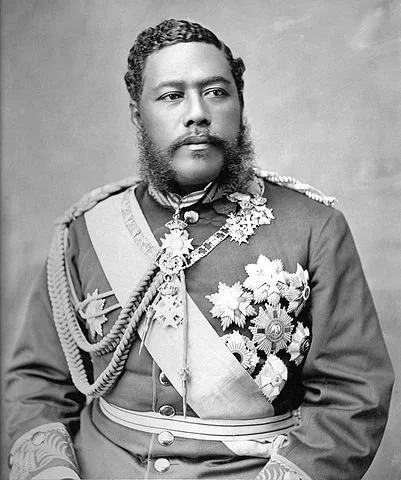Members of the Constitutional Convention, Republic of Hawaii, 1894. Unknown author.
Temporarily thwarted in their bid for US annexation, the Provisional Government called a constitutional convention in June of 1894. 19 of its 37 delegates were selected by Sanford B. Dole, and the remaining 18 were elected. The constitution that was enacted, written primarily by Dole and Lorrin Thurston, established a president as the head of government, and converted the house of Nobles to a Hawaiian Senate, to more closely resemble the US government.
Voting rights were limited to male citizens of the Republic. Citizens naturalized before 1893 were excluded unless they were “a native of a country having, or have had, treaty relations with Hawaii.” This was designed specifically to exclude Chinese and Japanese citizens. Certain non-citizens could vote, if they received “certificates of service” or “letters of denization” from the Hawaiian government, provided they took an oath to support the constitution and republic, and to not aid any attempts to restore the monarchy. The vast majority of Native Hawaiians refused to take such an oath, leaving them ineligible to participate in elections or the government of their homeland.’
Following the forced adoption of the Bayonet Constitution in 1887, Native Hawaiian leaders formed the Hui Kālai ‘āina, roughly translated as “Hawaiian Political Association.” This group worked to organize petition drives to demand a new constitution. They remained active after the coup in petitioning the US to restore Queen Lili’uokalani. Another organization was formed after the overthrow by former Native Hawaiian legislators called the Hui Aloha ‘Āina, roughly translated to the “Patriotic league.” There were initially separate organizations for men and women. These groups were able to deliver petitions arguing against annexation and restoration of the monarchy with signatures of nearly all the 40,000 Native Hawaiians in the Republic.
Queen Lili’uokalani traveled to Washington DC 1897 to petition the Congress against annexation and to restore her monarchy. During this time she wrote “Hawai’i’s story by Hawai’i’s Queen.” Agents of the Republic were also in the capital lobbying William McKinley’s administration for annexation. As in 1894, both parties were unsuccessful in their efforts, and so the Republic endured. However events in 1898 would tip the scales in the annexationists’ favor.
President William McKinley and Vice President Theodore Roosevelt, circa 1900. Library of Congress
Spain had colonized islands in the Caribbean and Pacific for centuries. The country was wracked by internal and colonial revolutions throughout the 19th century. In Cuba, one in a long line of revolts had reached a critical mass in the 1890s. Subduing it required an economically suffering Spain to send more troops it could ill afford and use more brutal tactics than in the past. Notoriously, it sought to separate the general population of Cubans from the insurgents by removing them from their villages to several concentration camps.
These tactics were seized on by Americans eager to keep expanding US territory throughout the Western Hemisphere. Pro-war newspapers waged a boisterous campaign depicting Spain as an imperialist tyrant and demanding military intervention. The prospect was not popular with the general public or enough mainstream politicians to affect any official actions. William McKinley’s administration sought to secure Spanish withdrawal through diplomatic measures. On February 15th, 1898 a major explosion occurred on the USS Maine, a warship that had been sent to Havana Harbor in preparation to protect any American property should it be endangered during the fighting between the Cubans and Spanish. The ship sank soon after, killing over 250 crewmen. Multiple investigations followed from both Spanish and American governments. Most found that the explosion was the result of an accident in the coal bunker or magazines for its cannon, but some American investigators claimed it was caused by a Spanish torpedo or mine. The verdicts remain a matter of debate to this day.
The pro-war press and politicians used the incident to renew their cause, coining the rallying cry, “Remember the Maine! To Hell with Spain!” The incident did not immediately move the administration to declare war, but it provided enough pressure to sway public opinion and persuade a sufficient number of politicians. On April 20, McKinely signed a joint resolution drafted by Congress supporting Cuban independence and authorizing a naval blockade of Cuba. Spain responded by declaring war on the US. The US war effort included sending naval forces to all of Spain’s colonies, including Puerto Rico, Guam, and the Philippines. The Republic of Hawaii officially adopted a neutral stance in the conflict, but in reality made its harbors available for crucial feuling and resupply of the navy. Pro-annexationists in Hawai’i and the US used this to argue for the strategic necessity of US control of the islands. Spanish resistance was minimal and US casualties low, stoking the war fever throughout the country.
In July the Newlands Resolution accomplished the annexation of Hawai’i and the end of the war saw the US gain possession of Puerto Rico, Guam, the Philippines, and Guantanamo Bay on the edge of Cuba. By 1900 Congress had passed the Organic Act, making Hawai’i an official US territory.
Sources:
Queen Lili’uokalani- National Parks Service
Spanish American War in Hawai’i- Aloha Authentic
Joint Resolution to Provide for Annexing the Hawaiian Islands to the United States (1898)- National Archives
25% of Hawaii's Land (Crown Lands) Taken Illegally (Who Benefited?) with Donovan Preza M.A.- Hawaiian Kingdom Academia






